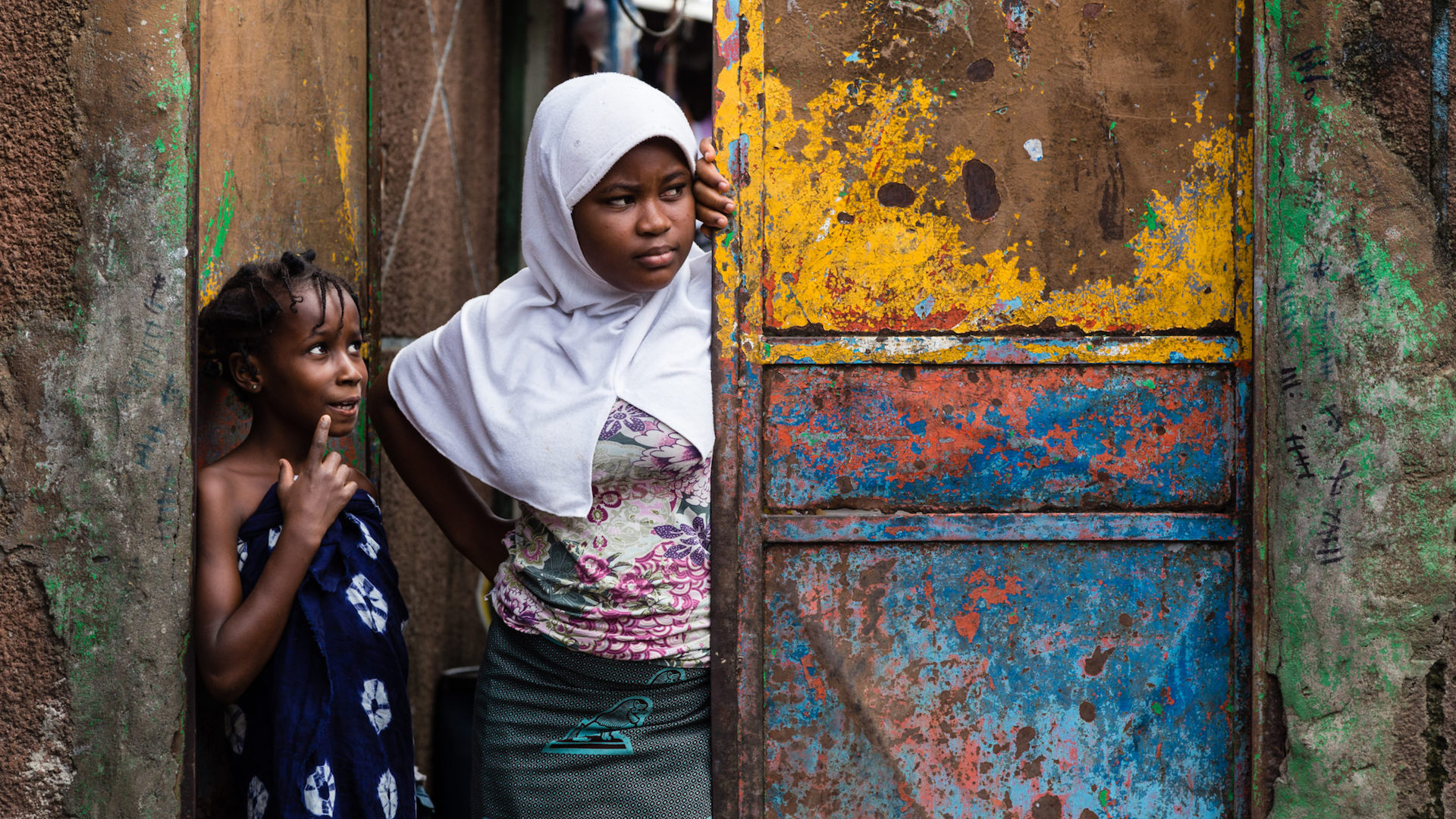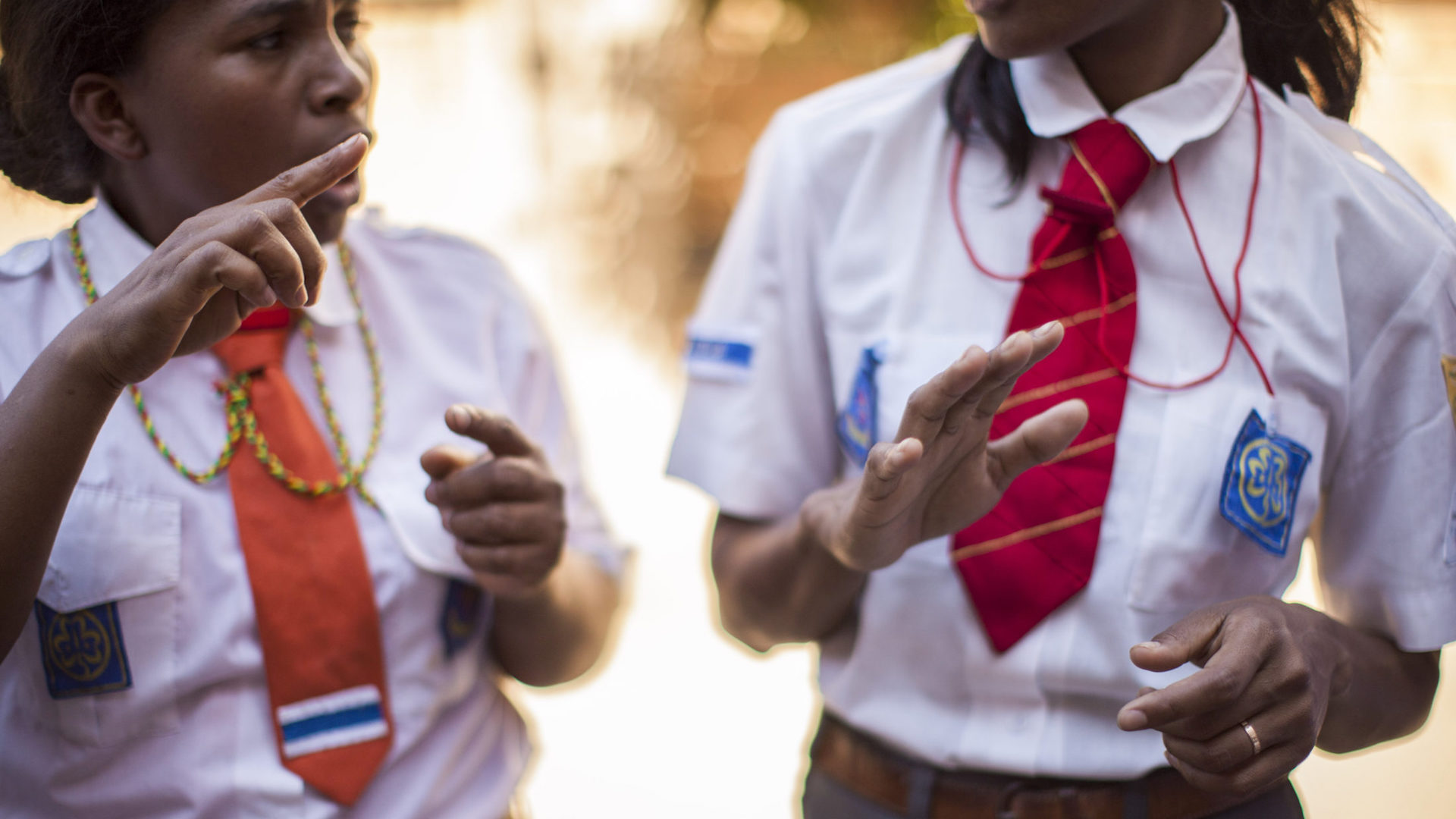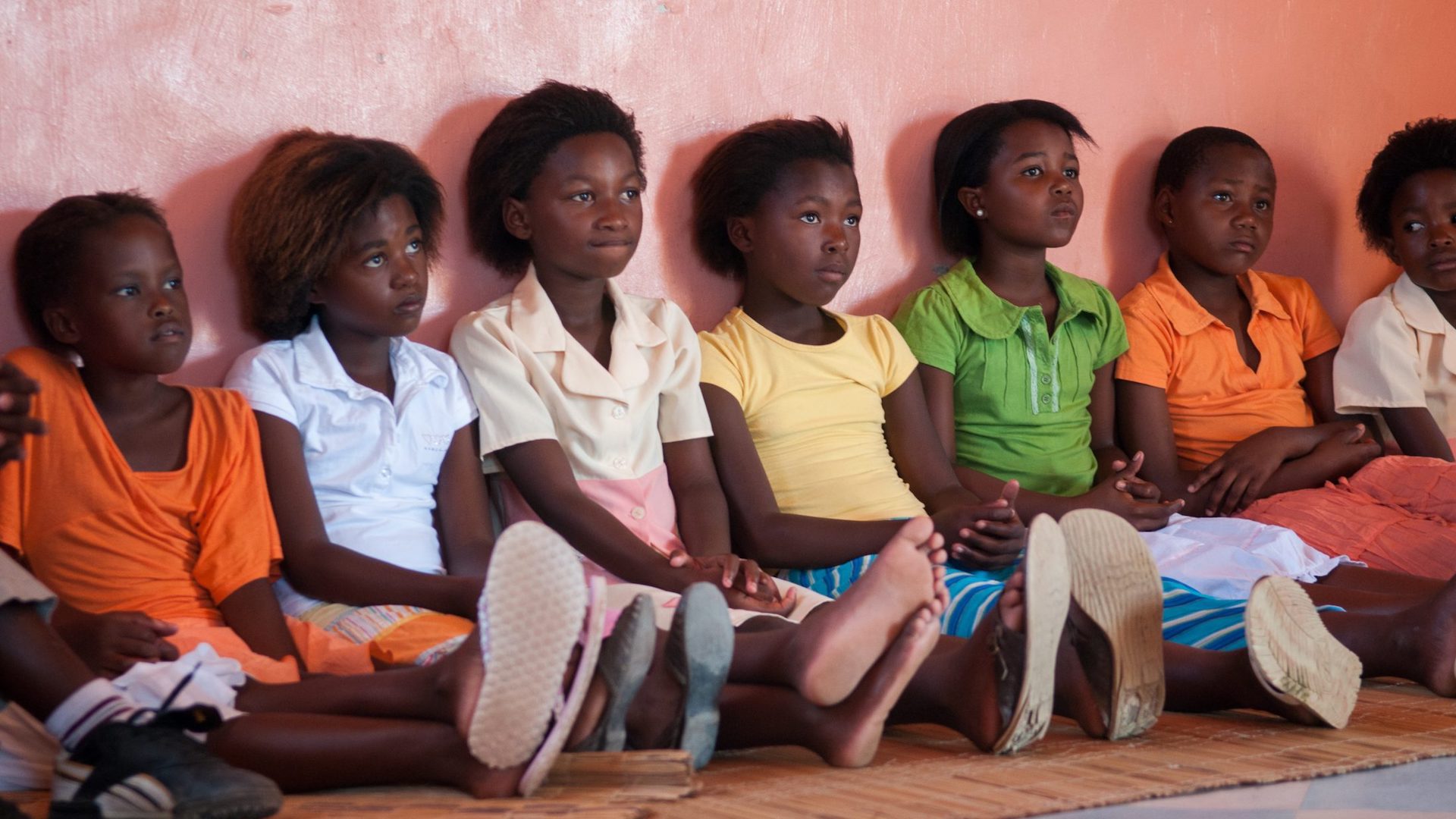
Religion—or a lack thereof—molds us. It guides our thoughts and perceptions, often without us realizing it. It shapes how we see the world and ourselves. Religion also affects men and women differently, depending on how practitioners interpret and apply teachings related to gender.
Here we focus on how religion impacts girls around the world. Each girl pictured is a representation of a majority in her region or country. We understand we’re offering generalizations, and, for anyone in any given place, intentionality and care are necessary to understand an individual’s story.
Yet however nuanced, each girl’s story will end the same if she dies apart from Christ. Pray that these precious ones will know the truth despite the many lies of religion that will follow them into adulthood.
Afghanistan

A schoolgirl in Afghanistan pauses for a photo during recess.
She is Muslim, like 99 percent of Afghanis. She will likely be married by eighteen, a mother by twenty, and have an average of five children. Many Afghan girls her age can’t read or write. Her country is slowly revitalizing women’s rights after decades of oppression due to civil conflict and Taliban influence, which fights to make Afghanistan an Islamic state.
Azerbaijan

Traditional Azeri music holds an important role for the young and old.
She and her family will tell you they are Muslim, though they don’t particularly practice it—they are Azerbaijani, therefore, they are Muslim. Her country’s rich musical traditions may have just as much influence over her as Islam does.
Bangladesh

A girl and her brother in Dhaka, Bangladesh.
She is young but will soon be married, as her family believes her physical maturity means she’s ready for marriage and childbearing. Her husband will be much older, and they will live with his family, in whose home she will work full time. Her country is one of the top five largest Muslim-populated countries in the world.
China

A girl worships at a Chinese temple. Photo by Luke In.
She worships in a Buddhist temple, mimicking the actions of her elders. While 18 percent of her country is Buddhist, more than half do not associate with any religion. She may watch her parents practice a mild form of ancestor worship, while young adults in her community come home from university and share new ideas, largely influenced by atheism.
Colombia

A baby naps at a dock area on the Amazon River in Columbia.
She will be raised Roman Catholic and attend Catholic schools, like many girls who grow up in Colombia. Yet instability may follow her wherever she goes as her country struggles against drug cartels and rebel fighters.
Ghana

A baby girl is carried on her mother’s back after being fed at the Baptist Medical Centre in Nalerigu, Ghana. Photo by William Haun.
She rides on her mother’s back after being fed at the Baptist Medical Centre in northern Ghana. Although her mother may have heard the gospel at this hospital, this young girl will later hear different stories about who Jesus is as she grows up—Protestants, Catholics, and Mormons send missionaries to her country.
India

A girl pauses from studying in Delhi, India.
She sits outside a place of worship in Delhi. Most of her country—nearly 80 percent—practices Hinduism. She was born into a lower caste and is taught to use religion to combat daily fears, fate, and sickness. The battle against evil feels real as many of her young friends are malnourished and under constant threat of disease, prompting continual fervent prayers and offerings to their Hindu gods.
Ivory Coast

Two young girls look out from their family’s courtyard in Koumassi, Abidjan, Ivory Coast. Photo by Max Power.
One wears a head covering because her family is Muslim, like nearly half of their country’s population. They have likely heard stories about the 2002 civil war between the predominantly Muslim north and Christian south, and have seen reports of Islamic militants attacking a beach resort near their city in 2016. Tension lingers between Christians and Muslims, though tolerance is encouraged.
Japan

A Japanese girl passes her baton in a relay race during a school outing at a local park. Photo by Luke In.
Her family practices Shintoism and Buddhism, a common combination of religious beliefs in Japan. She may hear about Christianity, but her focus will be on self-discipline and self-improvement, mastering the body through kata.
Madagascar

Deaf students at a Deaf school in Antananarivo, Madagascar sign with each other.
They speak to each other with their hands at a Deaf Christian school in Madagascar. They likely know other Deaf girls whose parents are ashamed of them and keep them home to work. Although they learn about Jesus at school, their community likely incorporates traditional religion into its practice of Christianity.
Migrant Camp

A temporary migrant camp at the border of Macedonia. Photo by Patrick Royals.
These girls are Muslim, an identity that helps them connect with a home culture that may seem so far away. For now, they live in a migrant camp in Europe, where they will remain for an unknown amount of time. Because of their unique situation, they may be married at a younger age than if they were still at home, so their husbands can protect and care for them in dangerous refugee environments. In desperate financial situations, their families may even allow their girls to be trafficked.
Mongolia

A Mongolian father introduces his daughter to her newborn sister. Photo by Caroline Anderson.
These sisters are from the land of Genghis Khan, whose ideas of strength and endurance have shaped their people for generations. Traditionally Mongols worship nature and their ancestors, though a majority now practices Buddhism. Their family is influenced by common superstitions, like letting a boy’s hair grow long in order to trick evil spirits—they believe spirits don’t attack girls.
Peru

Two Wanka Quechua school girls attend classes in San José de Quero, Peru.
These girls are from nominally Roman Catholic families, have attended mass only a handful of times, and couldn’t tell you about their religion. Yet being Catholic will remain central to their identity and family unity throughout their lives. A nun, grandmother, or priest may have warned them not to befriend non-Catholics, but they don’t see any harm in it.
Philippines

Many people in the Philippines move to big cities to work in factories. They often live in one-room homes in designated communities. Photo by Caroline Anderson.
She lives in a concrete box on the island of Cebu in the center of the Philippines. More than 80 percent of her people are Roman Catholic. Their religious practice involves worshiping images like the Santo Niño de Cebú (Holy Child of Cebu), a gift from Portuguese explorer Ferdinand Magellan.
Poland

A girl takes a selfie on the main market square, Rynek Główny, in Krakow, Poland’s second largest city. Photo by Patrick Royals.
She thinks she has been a Christian since birth but is more influenced by her peers and secular culture than anything else. When she was younger, her parents took her to a Catholic church where she learned strict moral values, but she noticed a separation between what the church taught and how people live. Such religion is an outdated practice that is adequate for her parents and grandparents, not her own generation.
Russia

A group of Russian girls walks through a park in Moscow, Russia. Photo by Patrick Royals.
They identify with the Russian Orthodox Church on paper, though they can’t recall much about what this religion teaches. They think it’s all fake, anyway, as they’ve grown up seeing a large disconnect between what the church teaches and how people live. Society has taught them that everything can be bought and sold, including God. They pursue education, beauty, and tangible possessions that seem more real to them than a God they don’t think they need.
South Africa

Girls listen in a church service in a small Xhosa-speaking community in Peddie.
Their people practice ancestor worship and fear terrible things may happen if they displease their ancestors. These girls learn to work hard to serve their families, and eventually their husbands. They start to carry water in a cup on their heads as early as five years old, and work up to a five-gallon bucket. At the time of marriage, they will be bought with cows to become part of their husband’s family.
South Sudan

A Dinka Agaar girl who had an eye infection four days earlier stands with her mother.
She is from the Dinka people, and her religious tradition will be dictated by her father, uncles, brothers, and eventually her husband. That religion may be animism, Christianity, Islam, or a combination of all three.
Taiwan

A girl feeds the pigeons with her father in front of the Chiang Kai Shek Memorial Hall in Taiwan. Photo by Caroline Anderson.
She is growing up in a very tolerant, yet very religious culture, with more than twenty-three thousand places of worship. According to her parents’ and grandparents’ wishes, she will participate in the religious acts of her family. Becoming a Christian would be unfaithful to them. When things don’t go well, she will try to fix them by offering prayers to different gods and worshiping her ancestors. She will feel pressure from her parents to work hard, go to the best schools, become financially successful, and marry by the age of thirty.
Tajikistan

A portrait of Tajik girls in Dushanbe.
They will grow up worshiping their imam, their Islamic leader. He gives their families spiritual direction and is central to their culture. He also will instruct girls to one day be hardworking and compliant wives and mothers. As early as age seven, they may stop playing outside with friends and start helping their mothers with chores at home. They’ve heard that Jesus was a good man, but if they believe him to be anything more, they will be ostracized from their families.
Thailand

A little girl drinks a juice box in a Tuk-Tuk along a busy road in Hua Hin, Thailand. Photo by Patrick Royals.
She is growing up in a Buddhist land, where her family goes to the temple to make merit, pray, leave donations, or listen to monks chant. When she grows up, one of her main roles will involve taking care of her elderly parents, who will likely live with her. Her family has a spirit house in front of their home where they will put out drinks and crackers to appease the spirits.
Uganda

A Ugandan girl hangs her laundry out to dry after washing it along the western bank of the White Nile. Photo by Max Power.
She hangs laundry to dry after washing it along the western bank of the White Nile River. Forty-five percent of Ugandans are Protestant, though the gospel they follow is likely diluted by the prosperity gospel or other heresies. She will likely raise an average of five children when she becomes a mom. Women are encouraged to focus on family, not education or work outside their home.
Venezuela

Many Warao children live in villages like San Jose de Waranoko in Venezuela.
They are Warao Indians whose people practice traditional beliefs based on ancestor worship, cosmology, and shamanism. They likely believe in an extensive supernatural world, and that serious illness and death are the result of the actions of spirits.
Libby Donaldson met Jesus at the age of sixteen. Today she serves in London as a writer for IMB with her husband and son.

